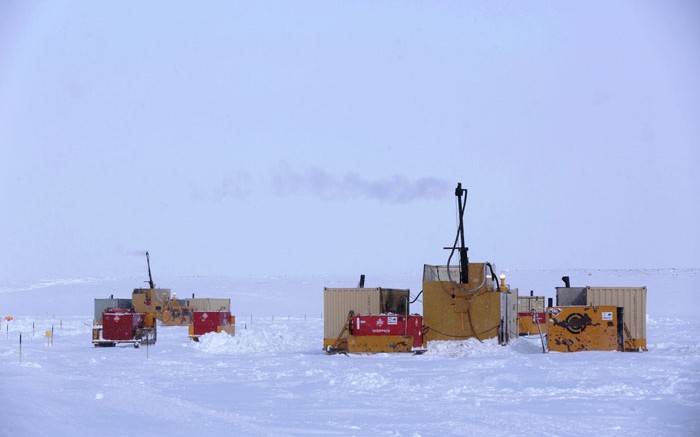Agnico Eagle Mines’ (TSX: AEM; NYSE: AEM) disciplined balance of costs and growth has set it up for a solid three years of production, despite the current market volatility.
The gold miner surpassed both its production and cost guidance for the fourth straight year in 2015, churning out 1.67 million oz. gold at total cash costs of US$567 per oz., net of by-products. It had guided production of 1.65 million oz. at total cash costs on a by-product basis of US$600. All-in sustaining costs (AISC) were US$810 per oz., below the expected US$850.
The higher production led to lower unit costs and more net free cash flow, helping Agnico cut its net debt position US$190 million last year and strengthen its balance sheet. During this time, Agnico also doubled its exploration spending and advanced its pipeline of development projects.
CEO Sean Boyd said on a conference call that 2015 was a success, “not only from an operating results point of view and improvement in financial flexibility, but also in terms of positioning Agnico for its next phase of growth … everything pretty much unfolded according to the plan that we outlined a year ago in 2015.”
However, the firm’s bottom line took a hit, after lower metal prices and higher exploration expenses in 2015. Net income was US$24.6 million, or US11¢ per share, compared to a profit of US$83 million, or US43¢ per share, in 2014.
On a brighter note, Agnico sees stable production and costs for the next three years from its existing mines. Production from 2016 to 2018 should average 1.5 million oz. gold a year. For 2016, production should be up to 1.56 million oz., slightly below the previous forecast of 1.6 million oz. This is due to the expansion of the Vault pit at the Meadowbank gold mine in Nunavut, which deferred ounces this year into 2017 and 2018, extending the mine life by a year.
Estimated AISC in 2016 are US$850 to US$890 per oz., with Agnico aiming to trim this in the next two years.
Reserves for 2015 increased 1 million oz., not quite replenishing the 1.8 million oz. that Agnico mined last year, Boyd says, noting the company lowered its gold price assumption for reserves by US$50.
On the resource side, inferred resources grew 23%, largely due to a resource increase from the Amaruq gold project in Nunavut, and initial resource estimates at the Sisar zone at the Kittila mine and the El Barqueno project.
Amaruq’s inferred resources grew 67% to 3.3 million oz. based on 16.9 million tonnes at 6.05 grams gold per tonne. A 75,000-metre drill program is underway to expand and upgrade the resource, and outline a second pit.
The company intends to develop Amaruq as a satellite operation to Meadowbank, which should finish production in late 2018. It plans to secure a permit for Amaruq this year, with construction anticipated in 2018, followed by production in 2019.
Boyd notes the project’s timeline depends on permitting. “We could actually have that thing built quickly, given that it is relatively straightforward … and we have the skill sets right in the region to do it, but it is really the permitting that drives that.”
Also in Nunavut, Agnico has slowed development at its large Meliadine project, pushing out the potential start-up by a year to 2020. Boyd says this was a prudent move amid today’s low gold prices.
Based on what Agnico knows about Amaruq and Meliadine, the Nunavut platform could become an annual 800,000 oz. producer soon, the executive says.
Along with Amaruq and Meliadine, the company anticipates El Barqueno in Mexico will add sizable production in 2019 and beyond. An initial estimate pegged El Barqueno’s inferred resource at 610,000 oz. based on 19.7 million tonnes at 0.96 gram gold.
Agnico has drilled another 11,000 metres since the estimate. It has 14 drills operating as part of this year’s US$13-million drill program at the project. The company says it could develop El Barqueno into a series of open pits using heap-leach processing, similar to its Creston Mascota project.
Agnico also published a maiden resource at the Sisar zone at its Kittila mine in Finland. The nearby zone hosts 650,000 inferred oz. from 3.4 million tonnes at 5.91 grams gold. Given its closeness to infrastructure, Sisar could drive free cash flow once developed, Boyd says.
Asked by an analyst how the company “walks the tightrope,” Boyd responded that “it’s a long-term business, and that is what really drives us.
“We’ve never sort of viewed this as a race … it’s more like ‘how do we move this thing forward and improve the quality of the business as we do it?’”
Agnico, which will celebrate its sixtieth year in the business in 2017, declared a quarterly dividend of US8¢ per share. It exited 2015 with US$131.6 million in cash, equivalents and short-term investments.


Be the first to comment on "Agnico sees ‘stable’ production for the next three years"